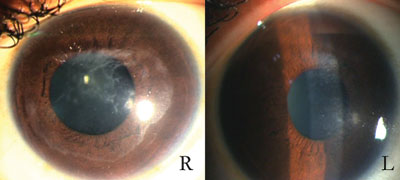Endothelial cell loss associated with diffuse lamellar keratitis after LASIK
Several etiological agents can be responsible for DLK, and the exact cause of the condition may not always be known.
 Amar Agarwal |
Diffuse lamellar keratitis is a white blood cell infiltrate between the flap and stromal bed that appears in the immediate postoperative period after LASIK. It is thought to result from an immune reaction to a variety of agents.
In this column, we present a report of irreversible endothelial cell loss after a LASIK procedure complicated by grade 4 diffuse lamellar keratitis (DLK).
Case report
A 22-year-old woman presented to us with a refractive error of –7 D sphere in both eyes and a best corrected visual acuity of 20/20 in both eyes. Ocular and systemic histories and examination were unremarkable. Her endothelial cell counts were 3,766 cells/mm² in the right eye and 2,898 cells/mm² in the left eye with a coefficient of variation of 13 and 29, respectively. Central pachymetry done by ultrasound was 587 µm in the right eye and 572 µm in the left eye.
Excimer laser ablation was performed in both eyes using the Bausch & Lomb Technolas 217z100 with the optical zone set at 6.5 mm. The patient was prescribed topical antibiotics, steroids and lubricants in the postoperative period. On the first day after surgery, she was noted to have dense interface infiltrates and flap edema in both eyes, being more severe in the right eye than in the left. In addition, she had stromal edema and radiating Descemet’s membrane folds in the right eye (Figure 1). The visual acuity at this point was 20/200 in the right eye and 20/100 in the left eye. Specular microscopy revealed endothelial counts of 1,232 cells/mm² and 2,512 cells/mm² with a coefficient of variation of 19 and 21 in the right and left eyes, respectively.
Management
Both the LASIK flaps were lifted and washed copiously with balanced salt solution. The patient was treated with intravenous methylprednisolone 500 mg once daily for the next 3 days followed by oral prednisolone 60 mg in the right eye and ibuprofen 80 mg three times a day. The frequency of the topical steroids was increased to once hourly, and 5% hypertonic saline twice hourly was started.
On the third postoperative day, the patient’s vision had improved to 20/80 in the right eye and 20/30 in the left eye with good recovery of edema in the left eye. The right eye, however, continued to have flap edema with a nonviable, nonadherent flap, which was amputated, and a bandage contact lens placed. The resulting epithelial defect healed over the next 2 days.
One month after surgery, both eyes had developed patchy corneal opacities (Figure 2), and the specular counts were 1,763 cells/mm² in the right eye and 2,055 cells/mm² in the left eye. The BCVA was 20/40 and 20/20 in the right and left eyes, respectively, at 6 months.
 Figure 1. Clinical photograph showing radiating Descemet’s membrane folds and flap edema in the right eye (R) and flap edema in the left eye (L) on the first day after surgery. Images: Agarwal A |
 Figure 2. Clinical photograph showing patchy scarring in the area of the flap in the right eye (R) and a diffuse nebular corneal opacity in the left eye (L) 6 months after surgery. |
Endothelial loss after LASIK
Transient endothelial damage in the form of both qualitative and quantitative changes has been seen immediately after LASIK; however, these changes were found to revert back to normal by the first postoperative day. These endothelial changes were attributed to the effect of excimer laser energy and/or the raised IOP during the LASIK procedure. Other factors postulated to damage endothelial cells include mechanical trauma from shock waves, thermal effects, actinic effects and metabolic changes occurring during LASIK. However, numerous long-term studies have shown that no permanent endothelial damage occurs after LASIK, possibly due to the limited penetration of the excimer laser wavelength into the corneal tissue.
The etiological agent responsible for DLK in our patient could not be ascertained definitively and could have been due to any one of meibomian gland secretions, microkeratome blade debris, marker pen ink or endotoxin. Endotoxin has also been shown to cause toxic endothelial cell destruction syndrome after cataract surgery.
We feel that endotoxin, which has been shown to cause both DLK and toxic anterior segment syndrome, may well be the etiological agent for both the DLK and endothelial cell loss seen in our case. As the endotoxin lies in the corneal interface, with no epithelial lining to prevent passage to the endothelium, it may diffuse through the stroma to reach the endothelium and damage it. This would probably happen only in cases with high amounts of endotoxin at the interface and consequently developing severe DLK.
Conclusion
This case report shows that severe DLK after LASIK may be associated with endothelial cell damage, both possibly being caused by bacterial endotoxins. Endothelial status should be monitored in patients with severe DLK.

- Amar Agarwal, MS, FRCS, FRCOphth, is director of Dr. Agarwal’s Eye Hospital and Eye Research Centre. Prof. Agarwal is the author of several books published by SLACK Incorporated, publisher of Ocular Surgery News, including Phaco Nightmares: Conquering Cataract Catastrophes, Bimanual Phaco: Mastering the Phakonit/MICS Technique, Dry Eye: A Practical Guide to Ocular Surface Disorders and Stem Cell Surgery and Presbyopia: A Surgical Textbook. He can be reached at 19 Cathedral Road, Chennai 600 086, India; fax: 91-44-28115871; e-mail: dragarwal@vsnl.com; Web site: www.dragarwal.com.
